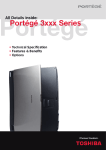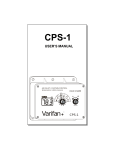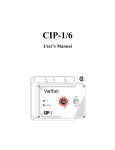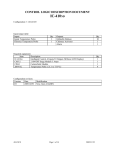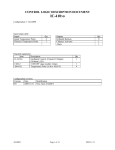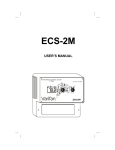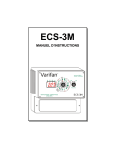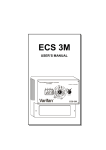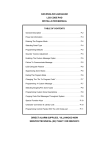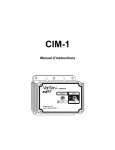Download + Varifan MST-1
Transcript
MST-1 CO RM /H HI T EA F2 DIFF on LO off IT L IM TIM ER reduc. per day OD PERI AL A RM O L AL A USER’S MANUAL 9 88 ADJUST Varifan + ® MST-1 MST-1 Although the manufacturer has made every effort to ensure the accuracy of the information contained herein, this document is subject to change without notice due to ongoing product development. WARNINGS AND PRECAUTIONS Equipment , probe failure, blown fuses and/or tripped breakers may prove harmful to the contents of the building. Therefore it is strongly recommended to install backup devices and alarm or warning devices. Spare equipment should also be available at the owner’s site. Equipment manufactured by the manufacturer is protected against normal line surges. High surges caused by thunder storms or power supply equipment may damage this equipment. For added security against line voltage surges it is recommended that surge and noise suppression devices be installed at the electrical distribution panel. Use of shielded cable for probes is recommended for protection against lightning. These devices are available from most electrical supply distributors. RECOMMENDATIONS The manufacturer recommends that all installation procedures described herein be performed by a qualified electrician or installation technician. Further more the manufacturer recommends to test all the functions and equipment connected to the MST including the alarm system and backup devices, after installation, after change to the installation and twice a year. Fuse verification and replacement, as well as the proper setting of control values shall be the responsibility of the owner of this equipment. Page 2 TABLE OF CONTENTS CHAPTER 1 - INTRODUCTION 1. 1.1 General .............................................................................. 5 Description .......................................................................... 5 Definition of terms ............................................................................ 7 CHAPTER 2 - INSTALLATION 2.1 2.2 2.3 2.3.1 2.3.2 2.4 2.4.1 2.4.1.1 2.4.1.2 2.4.2 2.5 2.5.1 2.5.2 2.6 2.7 Unpacking ............................................................................9 Mounting ...........................................................................10 Switch Settings...................................................................10 Line Voltage Selector Switch .............................................10 Software Settings Switch ...................................................11 Connection Procedure .......................................................11 Input Power ........................................................................11 115 VAC .............................................................................11 230 VAC .............................................................................12 Stage 1 ...............................................................................12 Temperature Probes ..........................................................12 Single Temperature Probe .................................................12 Averaging ...........................................................................12 Alarm ..................................................................................13 Powering Up.......................................................................13 CHAPTER 3 - USER’S GUIDE LED Status Window ...........................................................17 Control Dials.......................................................................17 PRIMARY FUNCTIONS Main Set Point Temperature ..............................................19 Stage 1 Differential.............................................................20 Stage 1 Duty Cycle timer ...................................................21 Page 3 MST-1 CONTENTS CONTINUED... Ramping .............................................................................22 Record Low Temperature ..................................................23 Record High Temperature .................................................24 Ambient Room Temperature Display .................................25 SECONDARY FUNCTIONS Heating or cooling mode ....................................................26 Duty cycle period................................................................27 Minimum Ramping .............................................................28 Low Temperature Alarm.....................................................29 High Temperature Alarm ....................................................30 APPENDIX Troubleshooting ..............................................................................31 Specifications ..................................................................................32 Record Form ...................................................................................33 Page 4 CHAPTER 1 - INTRODUCTION CHAPTER 1 - INTRODUCTION 1. GENERAL This document provides a description of the MST-1 control panel. This document is organized as follows: • • • • Introduction Installation User’s Guide Appendix 1.1 DESCRIPTION Congratulations on the purchase of your MST-1 environmental control system. The MST-1 product line provides you with full control over temperature, air flow, and heat resulting in a good air quality. The MST product line offers these features: • • • • Heating or cooling mode Hi/Lo temperature indication. Automatic temperature reduction (ramping). Computer compatible with RCM-40. The MST-1 provides microprocessor control over a single stage output. This stage controls a single speed fan or a heater. To cool the room when the temperature is higher than the main set point, use the MST-1 in cooling mode. Or to heat the room when the temperature is lower than the main set point, use the control in heating mode. In addition, the first stage may be programmed to cycle on and off. Page 5 MST-1 DESCRIPTION CONTINUED... The MST-1 provides you with full control over one stage via the use of an easy to follow display panel. All programmable features can be customized to meet your requirements. The MST-1 keeps you constantly informed by displaying the status of all of its outputs as well as the ambient temperature. Air quality is ensured by the continuous control of climate and timely alarm notification should environmental conditions exceed alarm set points. Further security may be obtained by connecting all MST series controls in a network configuration to a computer via the use of an optional RCM-40 remote monitoring unit. This provides remote control monitoring of each room. The control panel output is fused, and all programmable settings are maintained whether or not the MST-1 is powered. The MST-1 provides an automatic constant temperature reduction (ramping) feature for your maturing livestock. A built in low temperature safety factor prevents temperatures reaching dangerous limits. With MST-1 in control of your climate, you are assured of good air quality. Page 6 CHAPTER 1 - INTRODUCTION MAIN SET POINT The desired room temperature. Other temperature settings on the MST-1 are relative to the main set point temperature. AMBIENT TEMPERATURE The actual temperature of the room. RAMPING An automatic daily reduction in the main set point and all temperature settings relative to this. Page 7 MST-1 Page 8 CHAPTER 2 - INSTALLATION CHAPTER 2 - INSTALLATION The manufacturer recommends that the installation instructions which follow be adhered to as closely as possible, and all work be performed by a certified electrician. Failure to do so may void the warranty! 2.1 UNPACKING Unpack the MST-1 from its box and inspect contents for damage. Should the contents appear to be damaged, contact your local distributor for return material procedures. The package should contain the following standard items: • 1 MST-1 control . • 1 installed temperature probe (model number 2004-1KLT). • 2 cable fasteners or fuses. • 1 User’s manual. The following optional items may be included: • • 3 additional temperature probes for temperature averaging, 1 special temperature probe (model number 20011KHT). Page 9 MST-1 2.2 MOUNTING To limit the unit’s exposure to noxious gases install the unit in a hallway. Make certain that the unit is mounted right side up with the cable entry holes facing down. The MST-1 will operate in a temperature range of 32°F 120 °F (0 °C - 50 °C). The enclosure is watertight, it is not splash proof or immersion proof. DO NOT WATER the control. Cover the control carefully with plastic when you are cleaning the room. * It is prohibited to use overhead cables outside the building. Mounting hardware is not shipped with the unit. Mount the MST-1 to the wall using the mounting holes located on the flange of the control housing. Once the MST-1 is in place, use a screwdriver to remove the four screws holding the faceplate to the housing. 2.3 SWITCH SETTINGS The MST-1 is configured for a variety of options via two switches as follows: 2.3.1 - Line Voltage Selector Switch This switch is located on the surface of the main (bottom) board and adapts the control panel for 115 VAC or 230 VAC line voltage. 230V 115V Refer to Figures 1, and 2. Page 10 CHAPTER 2 - INSTALLATION 2.3.2 - Software Settings Switch This switch is located at the rear of the control panel faceplate and adjusts the following options. OFF ON OFF 1 2 3 4 Fahrenheit Settings locked Timer override active Not used ON Celsius Setting unlocked Timer override non active Not used Switch 1 Selects between a Fahrenheit or Celsius display on the front panel. Switch 2 Locks/unlocks user settings. All settings except for main set point, record low, and record high are locked while this switch is off. Switch 3 Non active: Timer operates normally. Active: Timer operates at 100% when temperature reaches 4°F (2°C) above the main set point. In this case, the temperature will decrease faster to the main set point (Heat, inverse logic). 2.4 CONNECTION PROCEDURE For the connection procedures which follow refer to Figures 1 and 2. 2.4.1 - Input power Use a screwdriver to remove cable knock-outs for the installation of cabling to the MST-1. Do not apply power to the MST-1 until all connections have been completed! 2.4.1.1 - 115 VAC Make certain that the line voltage selector switch is set to 115 VAC. Connect the power cable to terminals 3 and 4 on the main (bottom) board. Page 11 MST-1 2.4.1.2 - 230 VAC Make certain that the line voltage selector switch is set to 230 VAC. Connect the power cable to terminals 3 and 4 on the main (bottom) board. 2.4.2 - Stage 1 (terminals 5 and 6) Connect the two leads from Stage 1 to terminals 5 and 6 on the main (bottom) board. 2.5 TEMPERATURE PROBES Temperature probes use a “Class 2” low voltage circuit. These cables (#18AWG) can extend up to a distance of 500 feet (150 meters). For probe longer than 10 feet (3 meters), install shielded wire #18AWG min. With the shield grounded to ground of power source. Single probe connections. Single temperature probe connections are illustrated in Figure 3 while temperature averaging connections are illustrated in Figure 4. Use shielded cabling for probes when their cable paths run parallel to high voltage wires. Connect the shields to the ground of power source. Failure to do so may result in inaccurate readings! 2.5.1 Single Temperature Probe Install a single temperature probe in an area that best reflects the overall temperature of the room. Connect the two leads and the shield of the temperature probe to the MST-1 terminals labelled “Probe” as indicated in Figure 3. 2.5.2 Averaging (optional) Four temperature probes are required if temperature averaging is desired in larger rooms. Place the probes in appropriate locations to best average the ambient temperature. Refer to Figure 4. Page 12 CHAPTER 2 - INSTALLATION 2.6 ALARM The MST-1 provides a normally open and normally closed dry contact for alarming low or high temperature conditions. In addition, this same contact can be used to signal a power failure. This contact may be connected to an alarm system, or directly to a siren and/or auto-dialer. Make normally open or normally closed connections as indicated in Figure 3. Momentary power interruptions may trigger false alarms! To avoid false alarming when the MST-1 is connected to an alarm system, install a time delay relay between the MST-1 and the alarm system. 2.7 POWERING UP Before powering up the MST-1, attach the faceplate to the casing of the MST-1 using the four screws previously removed. Set Selector knob to position (12). Upon power up, the unit will test it’s display by briefly lighting all the segments of it’s LED. Make certain that all segments light. Following the LED display test, the unit displays the ambient temperature of the room. If the temperature is not displayed, refer to the Trouble Shooting section in the appendix of this document. Page 13 MST-1 Fig. 1 Wiring diagram for One Fan Fig. 2 Wiring diagram for One heating unit Page 14 CHAPTER 2 - INSTALLATION Note for figures 1, and 2 1 Power cut and protection devices in case of overload. Fig. 3. Temperature Probe and Alarm Wiring Page 15 MST-1 Fig. 4 Temperature Averaging Probe Connection Fig. 5 Main Board: Terminal, Blocks, Switches and Fuses. Page 16 CHAPTER 3 - USER’S GUIDE CHAPTER 3 - USER’S GUIDE The MST-1 front panel shown above features a LED status window and two control dials which are respectively used to select a function and adjust a setting. LED STATUS WINDOW The LED status window features a 3 digit LED readout for the display of temperature in Fahrenheit or Celsius and programmable settings. In addition, the LED status window displays the operational status of Stage 1 via one LED (shown above in LED window). When illuminated, the LED indicates that the stage is operating. The second LED lights to indicate a low or high temperature alarm condition. CONTROL DIALS The center dial is the Selector dial and is used to select one of the control panel’s 7 primary or 5 secondary functions. The dial located to the right of the Selector dial is the Adjustor dial and is used to enter secondary function mode and to adjust the setting of each function. Page 17 MST-1 The 7 primary functions are: • • • • • • • 1 Main set point temperature 2 Stage 1 differential temperature 3 Stage 1 duty cycle 9 Ramping 10 Record low temperature display 11 Record high temperature display 12 Ambient temperature display Any one of these functions is selected by rotating the Selector dial to the corresponding number and associated graphical image printed on the faceplate of the panel. When primary functions (1 through 3) and (9 through 11) are selected, the LED status window displays a blinking value. Function 12 displays ambient temperature. The 5 secondary functions are: • • • • • 2 Stage 1 Heating or cooling mode 3 Duty cycle period 9 Ramping minimum temperature limit 10 Low temperature alarm 11 High temperature alarm Select any one of these secondary mode functions by: • • • rotating the Selector dial to (12) rapidly rotating the Adjustor dial back and forth to enter secondary mode. rotating the Selector dial from function (12) to any other function. When secondary functions 2 and 3, and 9 through 11 are selected the status window displays a blinking value along with a scrolling LED display. Selection of function 12 removes the MST-1 from the secondary function mode. Page 18 CHAPTER 3 - USER’S GUIDE PRIMARY FUNCTIONS MAIN SET POINT The main set point establishes the target temperature in the building. This value is used as the reference point for other settings. The main set point temperature is adjusted in 0.5 degree increments from a minimum setting of 13.5°F (-9.5°C) to a maximum setting of 105.0° F (41.0°C). Adjusting the main set point temperature: • • rotate the Selector dial to position (1), rotate the Adjustor dial counterclockwise to decrease the temperature setting, clockwise to increase it. The main set point temperature is displayed on the MST-1. Note: The ramping feature (primary function 9) must be (OFF) to adjust the main set point. Page 19 MST-1 STAGE 1 DIFFERENTIAL In order to minimize erratic behavior of Heater / Fan 1 when ambient room temperature is exactly at the relative set point, the differential setting separates this ON / OFF threshold into two: one ON threshold and one OFF. This feature greatly reduces equipment wear. The temperature difference between the two thresholds is the differential. The differential is adjusted in 0.5 degree increments from a minimum setting of 0.5°F (0.5°C) to a maximum setting of 10°F (5°C) degrees. Adjusting the differential setting: • • rotate the Selector dial to position (2), rotate the Adjustor dial counterclockwise to decrease the differential setting, clockwise to increase it. The differential setting is displayed on the MST-1. Page 20 CHAPTER 3 - USER’S GUIDE STAGE 1 DUTY CYCLE As long as the actual temperature is below the main set point, the timer unit will not operate. When the ambient temperature rises above the main set point, the stage 1 begins to operate in a duty cycle mode. The duty cycle sets the percentage of time the stage 1 unit is ON versus the percentage of time the unit is OFF. The Stage 1 duty cycle is adjusted in 5% increments from a minimum setting of 5%, up to a maximum setting of 100% corresponding to continuous operation. Adjusting the duty cycle setting: • • rotate the Selector dial to position (3), rotate the Adjustor dial counterclockwise to decrease the duty cycle setting, clockwise to increase it. The duty cycle MST-1. setting is displayed on the Example: The period of Stage 1 is set to 8 minutes by secondary function (3), while the duty cycle is set to 75%. When the temperature reaches the main set point, the stage 1 begins to operates for 6 minutes, and shuts OFF for 2 minutes. Page 21 MST-1 RAMPING The ramping function automatically reduces the main set point by the set amount every 24 hours. The ramping setting is adjusted in 0.01 degree decrements from a minimum setting of OFF, -0.01°F (-0.01°C) to a maximum setting of -0.99°F (-0.50°C) The main set point must be greater than the limit. Adjusting ramping: • • rotate the Selector dial to position (9), rotate the Adjustor dial counterclockwise to decrease the ramping rate, clockwise to increase it. The ramping setting is displayed on the MST-1. NOTE: When ramping is activated or enabled, the main set point temperature cannot be manually adjusted. Ramping automatically turns OFF when the minimum temperature limit is reached! Example: The main set point temperature is set to 70°F and ramping is adjusted to -0.05°F. The following day the main set point temperature drops to 69.95°F followed by 69.90°F on the next. Although the main set point real value decreases, the display will be changed after 10 days. The main set point will then be 69.5°F. Page 22 CHAPTER 3 - USER’S GUIDE RECORD LOW TEMPERATURE This function displays the lowest recorded temperature since the last clear. The record low temperature is rounded to the nearest 0.5 degree from a minimum display of 13.5°F (-10.0°C) to a maximum display of 105.0°F (41.0°C). If a temperature lower than 13.5°F is recorded, Lo is displayed. Viewing the lowest temperature recorded: • rotate the Selector dial to position (10) Clearing the low temperature value: • quickly rotate the Adjustor counterclockwise, then clockwise. dial CLr will be briefly displayed on the MST-1. Page 23 MST-1 RECORD HIGH TEMPERATURE This function displays the highest recorded temperature since the last clear. The record high temperature is rounded to the nearest 0.5 degree from a minimum display of 13.5°F (-10.0°C) to a maximum display of 105.0°F (41.0°C). If a temperature higher than 105.0°F is recorded, Hi is displayed. Displaying recorded: • the highest temperature rotate the Selector dial to position (11) Clearing the high temperature value: • quickly rotate the Adjustor counterclockwise, then clockwise. CLr will be briefly displayed on the MST-1. Page 24 dial CHAPTER 3 - USER’S GUIDE AMBIENT ROOM TEMPERATURE DISPLAY This function displays the ambient room temperature. The Selector dial should normally be left in this position. The ambient temperature is displayed to the nearest 0.5 degree from a minimum display of 13.5°F (-10.0°C) to a maximum display of 105.0°F (41.0°C). If the temperature is lower than 41.0°F, Lo is displayed. If the temperature is higher than 105.0°F, Hi is displayed. Viewing the ambient temperature: • rotate the Selector dial to position (12) The ambient temperature is displayed on the MST-1. Page 25 MST-1 HEATING OR COOLING MODE Select if the MST-1 operates in heating mode or cooling mode. HEAT/COOL The stage 1 (heating or cooling mode) is adjusted by selecting HE or COO. HEA on the display if you want to use the stage 1 in heating mode or COO on the display if you want to use the stage 1 in cooling mode. Adjusting the stage 1 heating or cooling mode: • • • • rotate the Selector dial to position (12), rapidly rotate the Adjustor dial back and forth to enter secondary function mode, rotate the Selector dial to position (2), rotate the Adjustor dial counterclockwise to set the stage in heating mode, clockwise to to set it in cooling mode. The heating or cooling mode is displayed on the MST-1. Page 26 CHAPTER 3 - USER’S GUIDE STAGE 1 DUTY CYCLE PERIOD The Stage 1 duty cycle period is adjusted in conjunction with the Stage 1 duty cycle timer (primary function 3). The Stage 1 duty cycle period is the total time in ON-OFF fan cycle. Period The period is adjusted in 1 minute increments from a setting of 1 minute to a maximum setting of 10 minutes. Adjusting the Stage 1 duty cycle period: • • • • rotate the Selector dial to position (12), rapidly rotate the Adjustor dial back and forth to enter secondary function mode, rotate the Selector dial to position (3), rotate the Adjustor dial counterclockwise to decrease the period, clockwise to increase it. The Stage 1 period setting is displayed on the MST-1. Page 27 MST-1 MINIMUM RAMPING Minimum ramping is the lowest that the ramping function can adjust the main set point to. This is a security feature. Limit The minimum ramping setting is adjusted in 0.5 degree increments from a minimum setting of 13.5°F (-9.5°C) to a maximum setting of 105.0° F (41.0°C). Adjusting the minimum ramping setting: • • • • rotate the Selector dial to position (12), rapidly rotate the Adjustor dial back and forth to enter secondary function mode, rotate the Selector dial to position (9), rotate the Adjustor dial counterclockwise to decrease the minimum ramping setting, clockwise to increase it. The minimum ramping setting is displayed on the MST-1. NOTE: When the main set point temperature reaches the minimum ramping limit, the ramping setting (primary function 9) automatically shuts off. Page 28 CHAPTER 3 - USER’S GUIDE LOW TEMPERATURE ALARM This function establishes the temperature difference below the main set point that the room can reach before a low temperature alarm is signalled. When a low temperature alarm occurs an alarm contact is activated and the alarm LED lights on the MST-1. Alarm The low temperature alarm is adjusted in 0.5 degree increments from a minimum setting of 32.0°F (-18.0°C) to a maximum setting of 0.0°F (0.0°C) Adjusting setting: • • • • the low temperature alarm rotate the Selector dial to position (12), rapidly rotate the Adjustor dial back and forth to enter secondary function mode, rotate the Selector dial to position (10), rotate the Adjustor dial counterclockwise to decrease the setting, clockwise to increase it. The low temperature alarm setting is displayed on the MST-1. Page 29 MST-1 HIGH TEMPERATURE ALARM This function establishes the temperature difference above the main set point that the room can reach before a high temperature alarm is signalled. When a high temperature alarm occurs an alarm contact is activated and the alarm LED lights on the MST-1. Alarm The high temperature alarm is adjusted in 0.5 degree increments from a minimum setting of 0°F (0°C) to a maximum setting of 32.0°F (18.0°C) Adjusting the high temperature alarm: • • • • rotate the Selector dial to position (12), rapidly rotate the Adjustor dial back and forth to enter secondary function mode, rotate the Selector dial to position (11), rotate the Adjustor dial counterclockwise to decrease the setting, clockwise to increase it. The high temperature alarm setting is displayed on the MST-1. Page 30 APPENDIX TROUBLESHOOTING SYMPTOM CAUSE and REMEDY Lo is continually displayed − Temperature is below minimum (13.5°F or -10.0°C). − Probe is disconnected or defective. Hi is continually displayed − Temperature is above (105.0°F or 41°C). Probe is short circuited. Fan(s) or heater not operating − Verify whether the fan LED is on. If LED is on yet fan or heater is not operating, verify wiring, fan and fuse. Refer Figure 5 for fuse location. If fuse is blown, replace with fuse of same type. Display is blank − Verify that the line voltage selector switch is properly set. Verify that the 10 pin flat cable between the main board and the faceplate board is connected. − − maximum Page 31 MST-1 SPECIFICATIONS DESCRIPTION VALUE INPUT POWER − − − 6W 115/230 VAC 50 / 60 Hz STAGE 1 (dry relay contact) Fuse 10A − − − − − 10 A; 115V/230V 1/2 HP @ 115V 1 HP @ 230V Min. Rating 10mA at 115V* 20mA at 230V* ALARM (dry relay contact) − 2 A; 30V AC/DC * Relay will not function properly if load is smaller than the minimum value. Storage temperature: -20 to 55°C (-4 to 130°F) Operation temperature: 0 to 50°C (32 to 122°F) Weight: 1 kg (2.2 lbs.) Dimension: 97 X 163 X 145mm (3.80” X 6.40” X 5.70”) Page 32 APPENDIX RECORD FORM Dial Option Default setting 1 Main Set Point Temperature 77°F 25°C 2 Stage 1 Differential 4°F 2°C 4 Stage 1 Duty Cycle Timer 100 100 9 Ramping OFF OFF User setting 2nd Function 2 Heating or cooling mode COO COO 3 Duty cycle period 50% 50% 9 Minimum Ramping Limit 65°F 18°C 10 Lo Temperature Limit -9°F -5°C 11 High Temperature Alarm 20°F 12°C Page 33 MST-1 Page 34 WARRANTY Limited Warranty The manufacturered equipment and supplied components have gone through rigorous inspection to assure optimal quality of product and reliability. Individual controls are factory tested under load, however the possibility of equipment failure and/or malfunction may still exist. For service, contact your local retailer or supplier. The warranty period shall be for two years from manufacturing date. Proof of purchase is required for warranty validation. In all cases, the warranty shall apply only to defects in workmanship and specifically exclude any damage caused by over-voltage, short circuit, misuse, acts of vandalism, fortuitous events, acts of God, flood, fire, hail, lightning or any other natural disaster. Any unauthorized work, modification or repair on this product automatically voids the warranty and disclaims the manufacturer from all responsibility. The manufacturer assumes only those obligations set forth herein, excluding all other warranties or obligations. This warranty stipulates that in all cases the manufacturer shall be liable only for the supply of replacement parts or goods and shall not be liable for any personal injury, damages, loss of profits, interrupted operations, fine contravention of the law or damages to the production of the PURCHASER and the PURCHASER shall take up the defense and hold the manufacturer faultless regarding any legal or extra legal proceedings, notice, or claim by the customer or by a third party, and regarding any legal and extra legal expenses and fees brought forward on by such damages. Page 35 MAV MST-1M Ver: 1.01 June 4, 2001




































